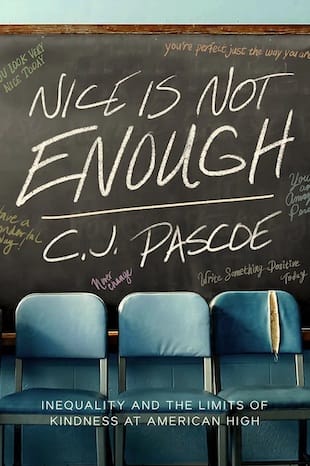Years ago, I did a year of ethnographic research in a historically white high school that understood itself to be a caring community for all students. Over months of attending classes and social events and interviewing students and teachers, I learned that the first students of color to enroll were often observers of staff's caring of other students, but not yet full recipients. The teachers were kind and friendly. But the school had a long tradition of ritualized acts of care for white students and had not yet learned how to see and hear what the students of color were experiencing from the margins. Later, I also co-edited a book with a colleague on the dilemmas of sustaining an ethic of care in diverse schools when students' lives are shaped by public indifference to inequalities.
Thus, when I saw the publication announcement of C.J, Pasoe's book Nice is Not Enough: Inequality and the Limits of Kindness at American High, I smashed the "order" button. In her ethnography, Pasoe introduces us to a U.S. high school serving diverse middle and working-class students, a school where messages against "hate" and for "love and kindness" are visible everywhere and permeate the school's talk about itself.

Yet in her months in the school, she finds that minoritized students, LGBTQ students, and low-income students were frequently thwarted from campus activism on their own behalf. The "political", they were told, would be divisive. Assemblies and posters and teacher talk of "inclusivity" all served to "shush" the experiences of students who were not white and middle-class and their attempts to push for change.
Pascoe writes of how framing inequality as expressions of individual hate, tolerance or inclusion does little to address questions of power and structural inequalities:
When we see inequality as an issue of individual hate, bias, prejudice, or ... bigotry, we can miss the way it operates in organizations like American High and in social institutions in general. These processes, the processes that make systemic inequalities look like individual ones, do the work of reproducing inequality with little overt hate or formal exclusion while simultaneously covering up this reproduction. Even in an organization where inequality is seen as undesirable, normalizing processes like that of the student citizen reproduce inequality without explicit processes of marginalization. Thus inequality at a school that has no room for hate becomes a matter of highlighting exceptional threats, individual feelings, individual solutions, and rituals of tolerance among young people and staff, rather than addressing the mundane and everyday ways inequality is instantiated.
Cultures of "kindness" without activism also leave all graduates ill-prepared to be agentive citizens.
Pascoe argues for a "politics of care" that goes beyond recognition to redistribution – redistribution of status, resources, opportunities, and in what students actually learn about why all the posters about "inclusion" and "tolerance" are needed in the first place.
So many campus first-generation support programs do an excellent job of "recognition" of students from poor and working-class backgrounds without ever talking about class inequalities. Few of these support programs invite students to explore what redistribution might look like, whether in the resources that students have available to them in deeply unequal K-12 schooling or on campus within prestigious majors and highest status social organizations that remain deeply segregated by race and class. Recognizing – and even celebrating - individual "first-gen" resilience and tenacity does little to teach anyone on campus about why so many students need to be so resilient in the first place. Pascoe's excellent book reminds us why students deserve so much more.




